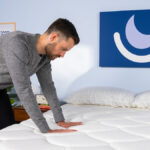A humidifier adds moisture to the air used in a continuous positive airway pressure (CPAP) machine, a common treatment method for people diagnosed with sleep apnea. By making the air more comfortable to breathe in, the humidifier helps reduce side effects such as a dry nose and throat.
CPAP humidifiers come in several different styles. We’ll explain how CPAP humidifiers work and discuss compatibility, what features to look for, and how to choose the best CPAP humidifier for your needs.
How CPAP Humidifiers Work
CPAP humidifiers add moisture to the airflow delivered by a CPAP machine.
During normal respiration, the nose warms air and adds moisture as it passes through, making breathing more comfortable. When you wear a CPAP mask, the air that enters your nose is pressurized. It passes through so quickly that the nose may not have time to humidify it, which can cause nasal dryness and irritation.
Most CPAP humidifiers consist of a water chamber with a hot plate. As the CPAP machine pulls in air, it passes over the heated water and takes in moisture before continuing down the tubing and reaching the CPAP mask.
Some humidifiers consist of only the water chamber, without the heating element. This style is sometimes called cold passover humidification, and it provides moisture without changing the temperature of the air.
Benefits of Using a CPAP Humidifier
Using a humidifier with your CPAP machine may reduce common side effects, including:
- Dry mouth and sore throat
- Dry nose, runny nose, or nosebleeds
- Nasal congestion
- Headache or sinus pain
- Reduced sense of smell
- Hoarse voice
People living in cold or dry areas and those who use indoor heating often experience stronger CPAP side effects and may receive more benefits from a humidifier. Heated humidification may also be helpful for people with nasal congestion or those who have had throat surgery to mitigate obstructive sleep apnea symptoms.
The American Academy of Sleep Medicine recommends always using a heated humidifier, and most modern CPAP machines include the option for heated humidification, but whether or not to use a humidifier is a personal decision.
How to Choose a CPAP Humidifier
Many CPAP machines on the market today come equipped with a built-in humidifier, so the need for humidification may play a role in which machine you choose. However, stand-alone CPAP humidifiers are also available. If you choose the latter route, it’s important to select a humidifier that’s compatible with your CPAP device. Other factors to consider include the size, price, and ease of replacement and maintenance.
CPAP Humidifiers
| Price | CPAP machines with built-in humidifiers bundle the price of the humidifier into the device cost. Prices for stand-alone humidifiers range from approximately $100 to $300. The water chamber needs to be replaced on a regular basis, which is another ongoing cost to factor into your CPAP therapy. If you wish to purchase heated tubing, this can run between $30 and $75, approximately twice the price of standard tubing. |
| Size | Humidifier water chambers tend to hold around 12 ounces of water. While stand-alone humidifiers typically occupy less than half a square foot on a nightstand, you’ll need to find a surface for the humidifier that is lower than your sleeping level to prevent water from traveling through the tubing into your mask. |
| Heated Humidifiers and Tubing | Most people prefer to heat their therapy air in addition to adding moisture. The two principal ways of heating the air for a CPAP machine are by using a heated humidifier or by adding heated tubing to warm the air as it passes through. You can use both a heated humidifier and heated tubing to reduce hose condensation if your bedroom is cold. You can also use heated tubing on its own if you live in a naturally warm and humid climate. |
| Maintenance and Replacement Parts | Before purchasing a humidifier, it’s worth checking how easy it is to procure replacement parts for that model. This is particularly true for the water chamber, which generally needs to be replaced twice a year. |
Where Can You Buy a CPAP Humidifier?
CPAP humidifiers are sold through brick-and-mortar durable medical equipment providers and through online outlets. Online stores typically offer more competitive pricing and a wider selection. If you have a specific brand in mind, or if you prefer to self-pay instead of being limited by your insurance plan, online outlets may be your best option.
Will Health Insurance or Medicare Cover the Cost of a CPAP Humidifier?
Medicare and many private insurers offer coverage for humidifiers that are used as part of CPAP therapy. Similar to other CPAP supplies, Medicare covers approximately 80% of the approved cost after you meet your Part B deductible.
Replacement schedules for water chambers may vary according to the insurance plan. Medicare covers the purchase of a new water chamber every six months.
Types of CPAP Humidifiers
CPAP humidifiers can come as stand-alone machines, built-in attachments, or optional integrated components designed for a specific CPAP machine.
Integrated and Built-In CPAP Humidifiers
While some manufacturers use the terms built-in and integrated interchangeably, there are slight differences between these two humidifier types. Built-in humidifiers are incorporated within the CPAP machine and cannot be removed — with the exception of the water chamber. Integrated humidifiers are sold separately by the machine manufacturer for use with that specific device, but they are optional and can be removed as needed.
Pros
- May take up less space than a stand-alone humidifier
- Can be controlled from the CPAP machine itself
Cons
- Only compatible with specific CPAP machine models
- Built-in humidifiers cannot be easily removed for cleaning, traveling, or repairs
Stand-Alone CPAP Humidifiers
Stand-alone CPAP humidifiers are sold separately from the CPAP machine. They may be made by the same manufacturer or a different one.
Pros
- Wider selection and compatible with many CPAP machine models
- May hold more water and provide more humidity than a built-in humidifier
Cons
- Require more space on a nightstand and need an additional electrical outlet
- Some CPAP machines are only compatible with specific models
Care and Maintenance for CPAP Humidifiers
Like other parts of the CPAP machine, humidifiers need to be cleaned on a regular basis.
How to Clean a CPAP Humidifier
In general, you should clean the humidifier water chamber once a week using warm water and mild soap. Remove any film and visible buildup, then rinse with warm water. Always unplug the machine before cleaning and let everything fully air dry before reassembling. Once a month, clean the water chamber more thoroughly with a diluted vinegar solution.
Cleaning instructions may vary slightly between models. For the best way to clean your humidifier and other CPAP components, refer to the manufacturer’s instructions in the user guide.
Distilled Water and CPAP Humidifiers
Because water from the humidifier is combined with pressurized air and enters your airway, it is important to use only distilled water in the humidifier chamber. During the distillation process, water is boiled into steam and then recondensed to remove impurities.
Using distilled water helps prevent mineral buildup in the water chamber and is also more hygienic than tap water, which can harbor potentially harmful pathogens.
How Often Do You Change Out the Water In a CPAP Humidifier?
To avoid bacterial growth, you should empty the humidifier water chamber daily after waking up and refill it just before bedtime. If you’re using the maximum level of humidification, you’ll probably find there’s little water left to empty in the morning. Don’t forget to let the water cool before emptying the water chamber.
Frequently Asked Questions
It’s possible to use a CPAP machine without a humidifier, but most people find it more comfortable to use one, and experts usually recommend it. The more comfortable you find CPAP therapy, the more likely you are to use your machine consistently.
Humidity settings are highly personal and depend on factors like CPAP air pressure, the temperature and humidity in your bedroom, and individual preferences. Setting the humidifier too low may leave you with a dry mouth and nose, while setting it too high may cause condensation.
A common problem with CPAP humidification is rainout, a term for condensation that forms in a CPAP hose or mask when the temperature of the tubing is lower than that of the humidified air. You can reduce rainout by turning down the humidifier temperature, using heated tubing, or using a cover to insulate the tubing.
It is not safe to add essential oils or other aromatherapy products to your humidifier water. CPAP humidifiers are designed to be used with distilled water only, and foreign substances may affect the way the humidifier works or damage the machine.
You shouldn’t use tap water in a CPAP humidifier, but you can use bottled water if it’s labeled as distilled. Distillation eliminates microbes and minerals. By contrast, tap water is generally safe to drink but may still contain bacteria or other microorganisms that can be unsafe to breathe.
References
Ask the Sleep Doctor
Have questions about sleep? Submit them here! We use your questions to help us decide topics for articles, videos, and newsletters. We try to answer as many questions as possible. You can also send us an email. Please note, we cannot provide specific medical advice, and always recommend you contact your doctor for any medical matters.


